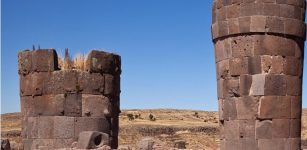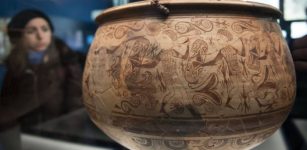Minutes Did Not Exist During The Middle Ages
Conny Waters - AncientPages.com - Medieval people used many instruments to keep track of time. During the Middle Ages, a combination of water clocks, sundials, and candle clocks could tell time, but none could determine the time to the minute.
Prague astronomical clock. Steve Collis from Melbourne, Australia - CC BY 2.0
Minutes were simply not used to measure time during the Middle Ages. Both the medieval and modern "day" (sunrise to sunrise) contain 24 hours, but medieval hours varied in length with the month and the time of day.
While the best water clocks told time to the quarter hour, people could tell time to the minute until the wide use and improvement of mechanical clocks.
On the equinoxes (March 21 and September 21), a medieval daylight hour equaled a nighttime hour, each containing a modern 60 minutes. But on Christmas in medieval London, a daylight hour contained only 40 minutes, while each nighttime hour contained 80 minutes. Of course, on St. John's Day (June 24), a medieval daylight hour in London had 80 minutes, and a nighttime hour contained only 40 minutes.
Žatec clock. Tower clock of Hop and Beer Temple. image credit: Martin Stross - CC BY-SA 3.0
We measure time in units of sixty because we still use the system worked out by the Sumerian civilization, which flourished in Mesopotamia about 2,000 B.C.E.
The Sumerians invented the Sexagesimal System based on the number 60. Sixty seconds in a minute, sixty minutes in an hour - and the Sumerians also had a calendar with 360 (60x6) days in a year. To make it work for all time units, the Sumerians also fixed twelve hours (double six) in a day, midnight, and roughly 12 months in a year (especially in a 360-day year).
The Babylonians, who lived after the Sumerians in Mesopotamia, also based their mathematics on the number 60. It was because the number 60 is a superior, highly composite number, having factors of 1, 2, 3, 4, 5, 6, 10, 12, 15, 20, 30, and 60.
The ancient Egyptians were no different and used time calculation on the number 60. They divided their year into three 120-day seasons of four months of 30 days. They defined the hour as either 1/12 of daytime or 1/12 of nighttime.
However, it took a long time before we started using minutes as a time measurement.
Jost Burgieven is credited with inventing the minute hand in 1577. The minute hand was not widely added to clocks until the 1680s. The mechanical clock was developed to a reasonable accuracy level in the 14th and 15th centuries.
In the 17th century, pendulum clocks were developed, enabling the measurement of seconds and minutes. The Royal Society in the U.K. first proposed the second as a unit of time. The duration of a beat or half period (one swing, not back and forth) of a pendulum one meter in length on the earth's surface is approximately one second.
Written by Conny Waters - AncientPages.com Staff Writer
Copyright © AncientPages.com All rights reserved. This material may not be published, broadcast, rewritten or redistributed in whole or part without the express written permission of AncientPages.com
Expand for referencesMore From Ancient Pages
-
 Fascinating Portable Art From Torre Cave, Gipuzkoa – One Of The Most Complete Specimens From The Entire Iberian Peninsula
Archaeology | May 26, 2023
Fascinating Portable Art From Torre Cave, Gipuzkoa – One Of The Most Complete Specimens From The Entire Iberian Peninsula
Archaeology | May 26, 2023 -
 Ancient Ziggurat Of Aqar Quf Dedicated To God Enlil
Civilizations | May 3, 2019
Ancient Ziggurat Of Aqar Quf Dedicated To God Enlil
Civilizations | May 3, 2019 -
 Patara Lighthouse Built By Emperor Nero In 64 AD Will Shine Again
Archaeology | Mar 5, 2020
Patara Lighthouse Built By Emperor Nero In 64 AD Will Shine Again
Archaeology | Mar 5, 2020 -
 Mysterious White Mass On The Heads Of The Tarim Basin Mummies Identified
Archaeology | Oct 1, 2024
Mysterious White Mass On The Heads Of The Tarim Basin Mummies Identified
Archaeology | Oct 1, 2024 -
 When And Why Did Humans Start Using Tombstones?
Archaeology | Aug 29, 2022
When And Why Did Humans Start Using Tombstones?
Archaeology | Aug 29, 2022 -
 Huge, Cylindrical Pre-Incan Chullpas Of Sillustani, Peru Were Used As Graves For Colla Nobles
Civilizations | Mar 14, 2023
Huge, Cylindrical Pre-Incan Chullpas Of Sillustani, Peru Were Used As Graves For Colla Nobles
Civilizations | Mar 14, 2023 -
 Vishnu: Supreme, Universal Hindu God Whose Avatars Reach Nations, Cultures And Races
Featured Stories | Jul 25, 2019
Vishnu: Supreme, Universal Hindu God Whose Avatars Reach Nations, Cultures And Races
Featured Stories | Jul 25, 2019 -
 Tír na nÓg – Mythical Land Where Time Floats Slower Than In Mortal Lands
Celtic Mythology | Mar 2, 2020
Tír na nÓg – Mythical Land Where Time Floats Slower Than In Mortal Lands
Celtic Mythology | Mar 2, 2020 -
 Fossil Tooth Analysis Sheds More Light On Earliest Humans From Southern Africa
Archaeology | Jul 15, 2022
Fossil Tooth Analysis Sheds More Light On Earliest Humans From Southern Africa
Archaeology | Jul 15, 2022 -
 Ancient Secrets Of Iberian Warrior Vase – 2,000-Year-Old Masterpiece Of Art
Archaeology | Dec 5, 2017
Ancient Secrets Of Iberian Warrior Vase – 2,000-Year-Old Masterpiece Of Art
Archaeology | Dec 5, 2017 -
 Unsolved Mystery Of The Giant Footprints Outside The Ain Dara Temple
Featured Stories | Jun 7, 2014
Unsolved Mystery Of The Giant Footprints Outside The Ain Dara Temple
Featured Stories | Jun 7, 2014 -
 Secrets And Lies: Spies Of The Stuart Era Played A Dangerous Game In The Shadows Of An Unstable Europe
Featured Stories | Nov 11, 2024
Secrets And Lies: Spies Of The Stuart Era Played A Dangerous Game In The Shadows Of An Unstable Europe
Featured Stories | Nov 11, 2024 -
 Magnificent Burial Chamber Of Idy, Ancient Egyptian Priestess Of Goddess Hathor Discovered In Asyut
Archaeology | Nov 15, 2024
Magnificent Burial Chamber Of Idy, Ancient Egyptian Priestess Of Goddess Hathor Discovered In Asyut
Archaeology | Nov 15, 2024 -
 Drought Reveals 2,000-Year-Old Rock Carvings In Brazil’s Amazon
Archaeology | Oct 23, 2023
Drought Reveals 2,000-Year-Old Rock Carvings In Brazil’s Amazon
Archaeology | Oct 23, 2023 -
 Great Easter Traditions Passed Down Over Centuries And Widely Practiced
Ancient History Facts | Mar 25, 2016
Great Easter Traditions Passed Down Over Centuries And Widely Practiced
Ancient History Facts | Mar 25, 2016 -
 Surprising Discovery In Valsgärde Viking Boat Graves – Scandinavian’s Oldest Down Bedding Found
Archaeology | Mar 27, 2021
Surprising Discovery In Valsgärde Viking Boat Graves – Scandinavian’s Oldest Down Bedding Found
Archaeology | Mar 27, 2021 -
 How Norwegians Expressed Resistance Against Nazi Occupation Using Christmas Cards
Featured Stories | Dec 21, 2023
How Norwegians Expressed Resistance Against Nazi Occupation Using Christmas Cards
Featured Stories | Dec 21, 2023 -
 LIDAR Discovers Huge Abandoned Zapotec City With Temples, And Ball Courts In Oaxaca, Mexico
Archaeology | Jan 30, 2025
LIDAR Discovers Huge Abandoned Zapotec City With Temples, And Ball Courts In Oaxaca, Mexico
Archaeology | Jan 30, 2025 -
 Who Deceived Mighty Yuku God Of Rain And Thunder In Beliefs Of Yaquis Of Southern Arizona And Sonora, Mexico?
Native American Mythology | Dec 21, 2023
Who Deceived Mighty Yuku God Of Rain And Thunder In Beliefs Of Yaquis Of Southern Arizona And Sonora, Mexico?
Native American Mythology | Dec 21, 2023 -
 London’s Underground Rivers Were Deliberately Hidden
Featured Stories | Oct 8, 2018
London’s Underground Rivers Were Deliberately Hidden
Featured Stories | Oct 8, 2018


